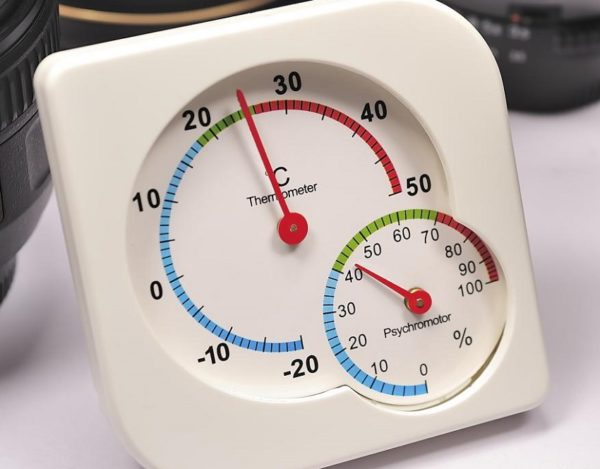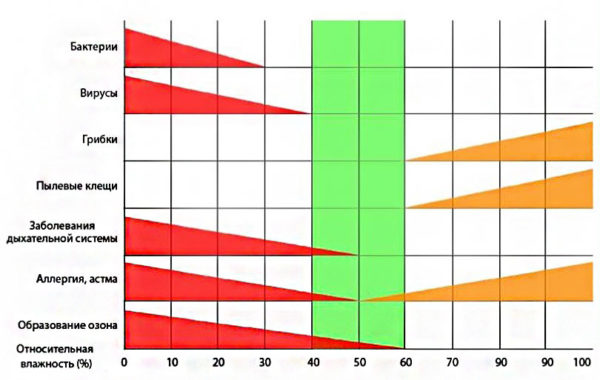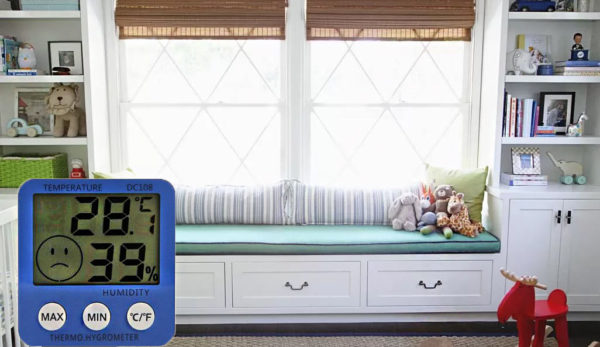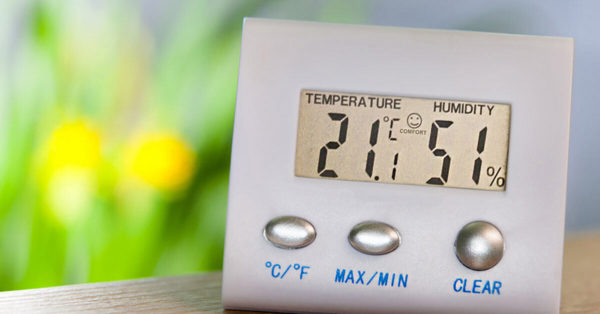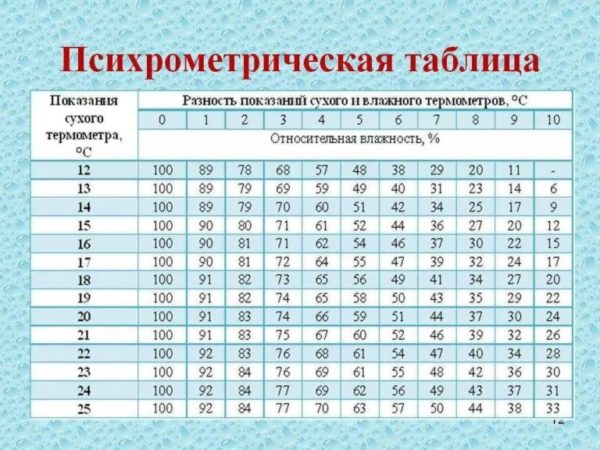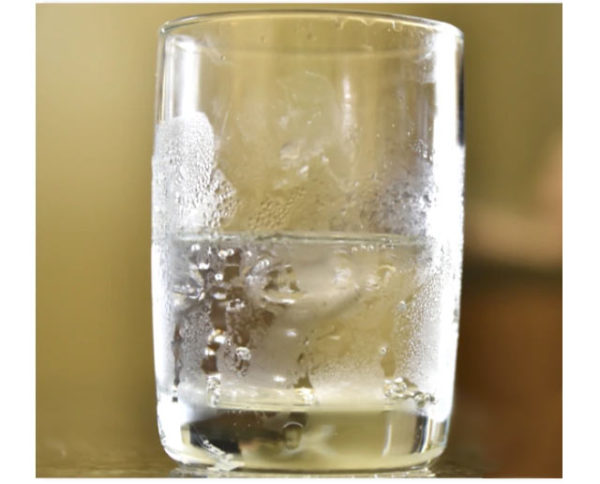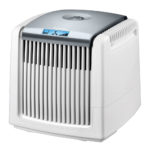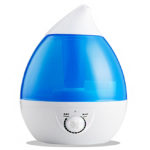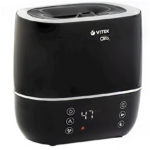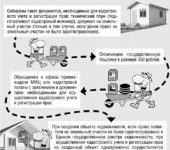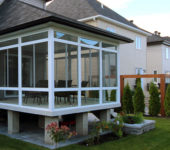What humidity should be in the apartment
The optimal air humidity in the apartment is determined by the standards of GOST and SanPiN, human well-being, the season, the purpose of the room. An average figure of 40-60% is considered the norm. If the content of water vapor in the air is higher, favorable conditions are created for the development of fungus on the walls, and with excessive dryness, the mucous membranes of a person dry out, itching of the skin and coughing may appear.
The content of the article
- 1 What is air humidity
- 2 How is humidity measured?
- 3 What does the deviation from the norm lead to?
- 4 The rate of humidity in the apartment
- 5 The norm of air humidity in the child's room
- 6 How to measure humidity
- 7 How to increase air humidity with household appliances
- 8 How to increase air humidity with folk remedies
- 9 How to reduce humidity
- 10 conclusions
What is air humidity
In molecular physics, air humidity is understood as the content of water vapor molecules in the air around a person. One hundred percent humidity is characterized by the appearance of condensation on surfaces. On the street, with such indicators, precipitation falls.
Normal humidity in a living area is usually different from that outside. In an apartment, it is more stable, while in the environment it changes under the influence of the changing seasons - in autumn and spring it is higher, in winter with frosts and in summer in extreme heat - lower.
Humidity fluctuations are due to temperature. If it is too high, water molecules evaporate, and if it is too low, it crystallizes. In a dwelling, the air is most often made dry by central heating radiators.
How is humidity measured?
The ideal air humidity in an apartment is that at which a person feels comfortable. The definition uses the concept of relative humidity (RH). Unit of measurement - g / m3, gram per cubic meter. Modern hygrometers show the normal humidity in the house in percentage terms.
What does the deviation from the norm lead to?
If the average room humidity is significantly higher than the norm (more than 20-30%), various problems may arise:
- The appearance of mold. A humid and warm environment is optimal for the development of fungal spores. Mold often forms in the bathroom, kitchen, in the corners of rooms. In children and people with weakened immune systems, it can cause respiratory problems and allergic reactions. For asthmatics, damp rooms are dangerous because prolonged exposure to them provokes frequent attacks.
- Increased heat transfer. In hot summer weather, the high temperature is less felt with an increased content of moisture particles in the air. Overheating or heatstroke can result.
It is the state of health of the occupants of the premises that determines what humidity should be in the house. Too high is not suitable for asthmatics, allergy sufferers, young children, people with hypertension, cardiovascular disease and immunodeficiency.
If the humidity in the room for a person is not met and the air is too dry, this is also harmful to health:
- Dry mucous membranes. This can manifest itself as itchy and irritated eyes, especially in people with contact lenses, a sore throat, and a hacking cough.
- Difficulty breathing. When dry, the mucous membranes of the nasopharynx do not fulfill their protective functions. A person becomes susceptible to colds and infections, nosebleeds, chronic rhinitis, exacerbation of bronchial asthma.
- Deterioration of the skin condition. Peeling, irritation, redness, the appearance of wrinkles - all this occurs against the background of a violation of the hydrobalance of the skin.High humidity is especially bad for people with psoriasis, atopic dermatitis and other dermatological diseases.
Most of the unpleasant symptoms do not appear immediately. But if there is no normal humidity in the apartment, sooner or later its residents will begin to experience discomfort.
The rate of humidity in the apartment
Recommended GOST 30494-96 air humidity in the room, depending on the season:
- in winter - 30–45%;
- in the autumn-spring period - 30–45%;
- in summer - 30-60%.
Optimum indoor humidity for a person of different ages:
- for adults - from 40 to 60%;
- for children under 6 years old - 50-60%.
The ideal air humidity in an apartment for a person varies depending on the purpose of the room:
- in the bathroom, where the decoration of the ceiling, walls and floor is usually resistant to water, the humidity can reach 60-70%;
- normal humidity in the rooms allocated for the kitchen, corridors, storerooms - 40-60%;
- in rooms where there are plants, the humidity should not be lower than 60–70%, for tropical and subtropical flowers - up to 80–95%, therefore it is recommended to take them out to the balcony, loggia or give them a separate room;
- on a loggia or balcony, it makes no sense to regulate the humidity, since this room is non-residential.
According to SanPiN 2.1.2.2645-10, the relative humidity for premises is enclosed in a more rigid framework and has values of 60% in the cold season, and 65% in the summer. Some rooms are not standardized due to an intermittent or short stay in them, as well as frequent and prolonged changes in humidity in these rooms.
| The name of a room | Air temperature, ° C | Relative humidity,% |
| winter | ||
| Living room | 18–24 | 60 |
| A room in the areas of the coldest five days (minus 31 ° C and below) | 20–24 | 60 |
| Kitchen | 18–26 | N / N * |
| Restroom | 18–26 | N / N |
| Bathroom, combined dignity. knot | 18–26 | N / N |
| Lobby | 14–20 | N / N |
| Pantries | 12–22 | N / N |
| summer | ||
| Living room | 20–28 | 65 |
* - not standardized
To increase the service life of household appliances, the preservation of books, paintings, upholstery of upholstered furniture, the humidity level should not exceed 60–65%.
The norm of air humidity in the child's room
The optimum air humidity for a child in an apartment is determined based on his age. Compliance with this parameter is especially important for newborns:
- Features of thermoregulation in infants. The drier the air (which the child inhales), the more fluid the body will spend to moisturize it. Large losses of water are associated with this - dryness of the nasopharyngeal mucosa and nasal cavity occurs, the baby has difficulty breathing. As a result, he often wakes up at night, eats poorly, and is capricious.
- Long heating season. In most Russian cities, it lasts at least 6 months a year. Central heating batteries can reduce the initial humidity in the room by 20–40% or more. Low humidity during the heating period is a frequent respiratory illness, chronic rhinitis, increased risk of bronchial asthma.
Depending on the age of the child, they determine what humidity should be in the bedroom. For children of the first year of life, the optimal parameter is 50–70%, for children from 1 to 3 years old - 45–65%, for children over 3 years old, almost adult norms are suitable - 50–60%.
How to measure humidity
The relative humidity in the room is measured using special devices - hygrometers. They have a different design and operating principle:
- Electronic. Usually combined with thermometers to simultaneously measure the room temperature. In them, an electrolyte is applied in a thin layer on the inner plate, through which the voltage passes. The results are displayed on the dashboard.
- Mechanical. Cheaper and easier-to-use devices, however, can give measurement errors up to 8%. They work without a power source, and are available as desktop or wall-mounted.They do not have a digital display, they are equipped with a dial and an arrow.
There are several ways to determine the saturation of air with moisture, not all of them are popular, but there are:
- Weighted or absolute. It is a device that detects relative humidity by absorbing it. With the help of special tubes with a chemical composition, he makes measurements. They are not used in domestic conditions.
- Hair.This type of hygrometer is used only in laboratories, and then only because its principle of operation is based on the study of human hair.
- Film. Also belongs to the category of laboratory instruments. The main mechanism is a special film, which, depending on the level of humidity, stretches or, conversely, shrinks. It is most effectively used in the winter season.
- Electronic. This type of device is most often purchased for household humidity measurements. It is quite simple to use it, since the mechanism displays the final measurement result on the touch screen immediately.
- Psychometric. The most accurate type of moisture meter. Often it is he who is purchased for work in production, laboratory premises. Also, many "civilian" users leave their choice on psychometric hygrometers because of their relatively low cost and extreme accuracy.
An inexpensive mechanical hygrometer is suitable for determining the rate of air humidity in an apartment. For domestic use, certification in the metrological service is not required.
It is important to pay attention to the temperature range of use - the maximum value is 80-120 degrees. When using in a sauna or bath, you must choose the extreme option.
Determine humidity without devices
You can independently find out the humidity in the room quite accurately without having instruments. There are two options for this.
When measuring in the first way, you need to measure the air temperature in the room with a thermometer and record the readings. Then take a small piece of a cloth or bandage, wet it and leave the tip of the thermometer for 5 minutes. Then, after calculating the difference in readings (we subtract less from the larger one), you need to use the psychrometric table.
In the second case, pour a glass of water and cool it in the refrigerator to + 3 ... + 5 ° C. After that, move the glass to a room away from heating appliances and leave for 10 minutes. We look at the glass if:
- The glass is dry. The humidity in the room is insufficient.
- There is condensation on the walls. The humidity is okay.
- Large condensation and drips. The humidity is too high.
How to increase air humidity with household appliances
The most affordable and popular device for increasing air humidity is a household humidifier. It can be used all year round, but it will be especially useful in winter, when the humidity of 20 percent indoors causes discomfort.
The following types of humidifiers are available:
- Classic. The principle of operation of such devices is based on the evaporation of cold water without preheating. From a special container, water flows onto the evaporator - a disc, filter or cartridge. Due to the fact that such devices take air from the room and release it after cleaning with a filter, additional dust and allergens are removed.
- Humidifiers with air cleaning function. These are full-fledged climatic devices that simultaneously increase the level of humidity and purify the air by equipping with special replaceable filters. They are also called air washers.
- Steam models. The principle of operation of such devices is similar to the operation of an electric kettle.Heating elements with ceramic plates or spirals release steam after preheating the water. It is optimal to use both in the summer and to comply with the humidity standards in the apartment in winter.
- Ultrasonic. Most expensive and efficient. The liquid poured into the reservoir enters the plate, vibrating under the influence of ultrasound. Water breaks down into tiny droplets, which enter the room through a cooler inside the case.
- Air humidifier with purification function (air washer)
- Steam humidifier
- Ultrasonic humidifier
With the help of such devices, you can not only create comfortable humidity in the apartment, but also regulate other parameters:
- control the temperature;
- neutralize pathogenic microbes;
- trap dust and allergens.
The action of the humidifier can cover different areas, which must be considered when purchasing. Small appliances are suitable for a bedroom or kitchen. For a living room or other rooms with a larger area, a powerful device is needed.
How to increase air humidity with folk remedies
Air humidity in a dry room can be increased using folk methods:
- regular wet cleaning;
- frequent ventilation (not in subzero temperatures), especially after rain;
- installation of a mini-fountain, an aquarium or other containers with water;
- cultivation of flowers and their regular watering;
- reducing the intensity of the heating radiators using wet towels;
- use of a spray bottle.
To increase the humidity in the room, you can dry the laundry directly indoors, rather than on the balcony or outside. Water vapor from boiling pots also gets into the air during cooking.
How to reduce humidity
High humidity is not always a blessing. If mold, fungus appears on the walls, condensation constantly collects, it must be reduced. You can use one of these methods:
- Dehumidifiers. Special devices that absorb excess water molecules, taking air from the room. The principle of operation of such a device is based on the condensation of steam in a room. Part of the functions of a dehumidifier is performed by an air conditioner - it also takes water from the air.
- Good ventilation. Clogged air ducts do not cope with the function of removing excess wet air from the apartment.
- Drying clothes outside or on the balcony. Drying, the fabrics release water molecules into the air, which circulates throughout the rooms and increases the humidity.
- Sunlight. Once in the room, it leads to the evaporation of water, so it is recommended to open windows regularly.
Some factors of increasing humidity cannot be influenced:
- the more people live in an apartment, the lower this figure will be;
- if all windows face the north side, the rooms are often damp;
- in some cities, climatic conditions determine constant high humidity.
conclusions
You can determine what humidity should be in an apartment using a household hygrometer. If the level is below 40%, use humidifiers or other available methods. When it exceeds 70%, it is necessary to reduce the number of sources of evaporation of water (indoor flowers, aquariums, containers with water, damp clothes) or use dehumidifiers.

